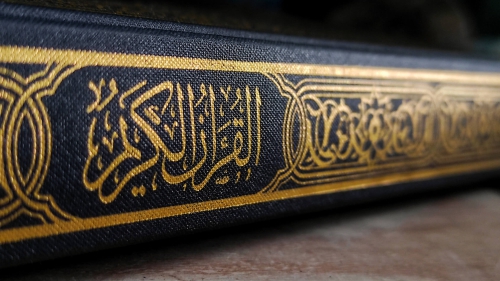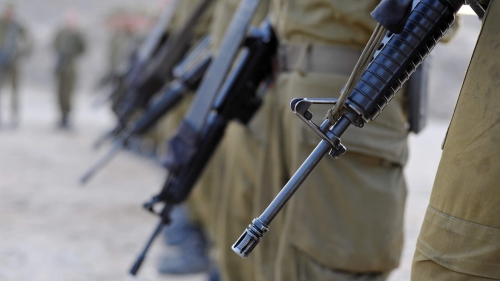History of Turmoil in the Middle East
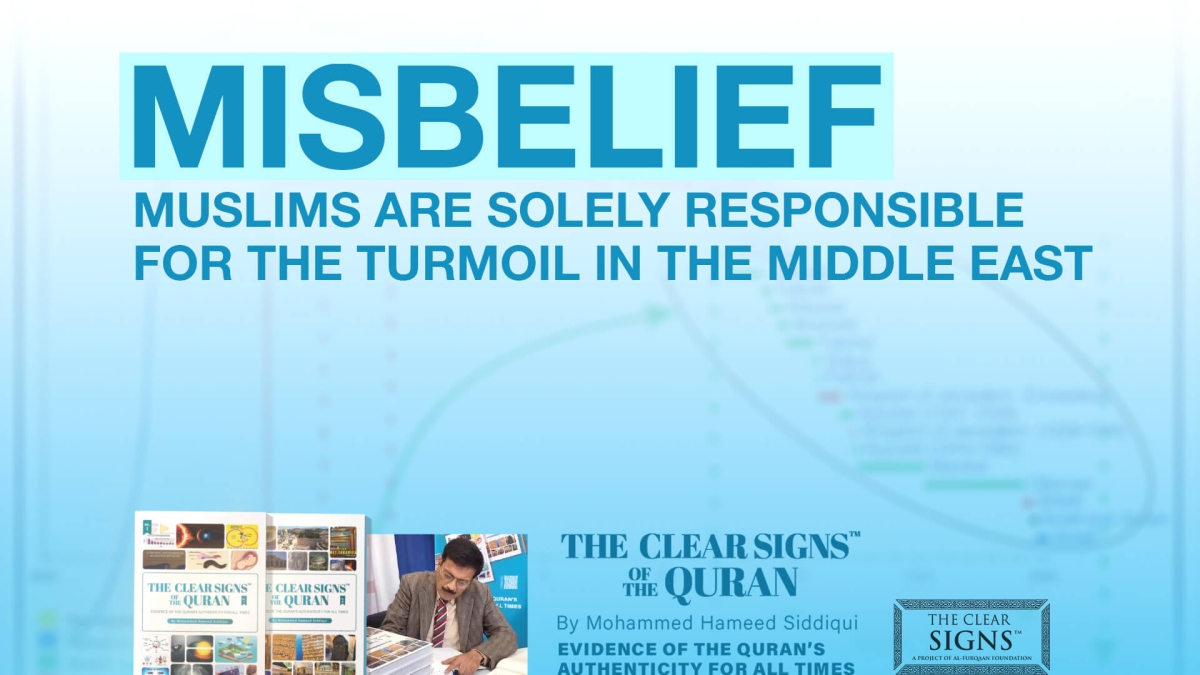
One look at the modern Middle East would show that none of these Muslim countries have been at peace for several decades. There are two aspects of these underlying problems.
Firstly, no policymaker, analyst, or average newsreader will get the region right without knowing its complicated backstory. Nobody wants to take time to do an in-depth investigation of the truth. Furthermore, there are geopolitical reasons to control the mind continuously and repeatedly; by giving one viewpoint, that viewpoint becomes a fact.
This transformation of untruth to reality is the power of modern media. On the other hand, there is perhaps some truth in this accusation relating to Muslim nations today under authoritarian rule or having poor leadership.
As a result, many Muslim countries have political turmoil. World powers support them for their benefit, such as keeping the arms race going, maintaining their supremacy and status quo to avoid oil supply disruption, hurting their economic interest, etc. But this accusation of Islam that it is not a peaceful religion is invalid. There are several geopolitical reasons for the lack of peace in the Muslim World. Let us first look at the plight of displaced Palestine people.
The partition of the Ottoman Empire1Pulitzer Prize finalist David Fromkin, “A Peace to End All Peace: The Fall of the Ottoman Empire and the Creation of the Modern Middle East 20th Anniversary Edition, Kindle Edition – Best Seller recognition. - “A Peace to End All Peace”
Economic weakening, a decline in the Sultan’s power, the loss of territory, corruption, and a succession of weak leaders weakened the Ottoman Empire and eventually collapsed. The partition of the Ottoman Empire was a political event that occurred after World War I. The occupation of Constantinople by British, French, and Italian troops took place in November 1918. The Allied Powers partitioned the Ottoman Empire in several agreements early during World War I, notably the Sykes-Picot Agreement.
As World War I raged, the Ottoman Empire sought protection but was rejected by Britain, France, and Russia, and finally formed the Ottoman–German Alliance. The vast number of territories, peoples, communities, and cultures formerly comprised the Ottoman Empire was divided ad hoc into several new states. The Ottoman Empire had been an actual Islamic state in geopolitical, cultural, and ideological terms.
The partitioning of the Ottoman Empire continued with the series of mandates, often with some vengeance (also, the name invented for footstool). Ottomans called themselves Devlet-i Aliyye-i Osmânî was the standard reference, meaning the Ottoman Empire (Supreme state). Ottoman is a European version of Turkish 'Osman,’ the first Ottoman ruler’s name, who lived in the early 14th century. From a minor beylik (the territory under the jurisdiction of a Chieftain, Bey. The feminine equivalent title was Begum) in Western Anatolia under the Seljuk Empire, Osman’s successors created one of history’s most potent Ottoman Empire.
The League of Nations mandate granted a French Mandate for Syria and Lebanon, a British Mandate for Mesopotamia (later Iraq), and a British Mandate for Palestine, then divided into Mandatory.
Palestine and the Emirate of Transjordan (1921–1946). The Ottoman Empire’s possessions in the Arabian Peninsula became the Kingdom of Hejaz, annexed by the Sultanate of Nejd (today Saudi Arabia), and the Mutawakkilite Kingdom of Yemen. Saudi Arabia annexed the Ottoman Empire’s territories of Al-Hasa and Qatif on the Persian/Arabian Gulf shores. The remaining British protectorates (Kuwait, Bahrain, and Qatar) became the Arab States of the Persian Gulf.
The strategy ensures infighting in the Middle East
The forcible carving out of nations like Iraq (from three disparate provinces of the Ottoman empire- Basra, Baghdad, and Mosul), Palestine, and forcible division of Syria along communal lines is thought by many analysts to have been a part of the broader strategy of ensuring infighting in the middle east, thus necessitating the role of Western colonial powers (at that time Britain, France, and Italy) as peace brokers and arms suppliers.

The Ottoman Empire at its greatest extent in Europe, under Sultan Mehmed IV in the late 17th century.
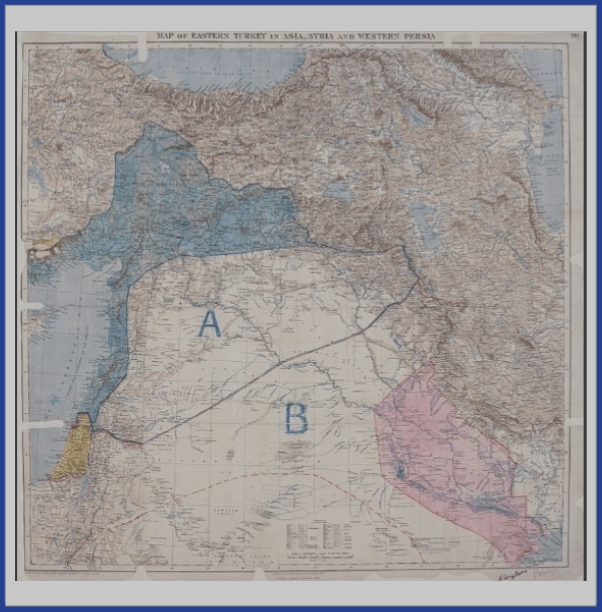
Map of Sykes-Picot Agreement.2https://en.wikipedia.org/wiki/Sykes%E2%80%93Picot_Agreement#/media/File:MPK1-426_Sykes_Picot_Agreement_Map_signed_8_May_1916.jpg showing Eastern Turkey in Asia, Syria, and Western Persia, and areas of control and influence agreed between the British and the French. Royal Geographical Society, 1910-15. Signed by Mark Sykes and François Georges-Picot, 8 May 1916.
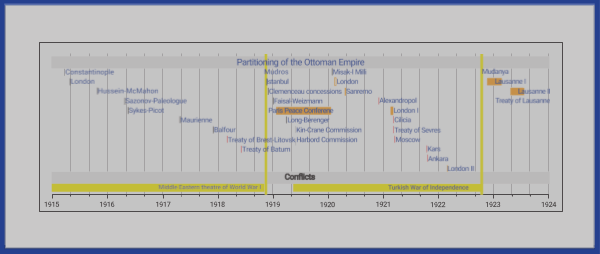
The breakdown of the Ottoman Empire.
Pulitzer Prize finalist David Fromkin wrote a history book in 1989 titled A Peace to End All Peace: The Fall of the Ottoman Empire and the Creation of the Modern Middle East (also subtitled Creating the Modern Middle East, 1914–1922), which describes the events leading to the dissolution of the Ottoman Empire during World War I, and the drastic changes that took place in the Middle East as a result, which he claims led to a new world war that’s still going on today.
The Quotations from the book A Peace to End All Peace:
- “When the British armed forces occupied the Middle East at the war's end, the region was passive.”
- “In retrospect, one sees Britain undergoing a time of troubles everywhere in the Middle East between 1919 and 1921, but it was not experienced that way, at least not in the beginning.”
- “The top British fantasy about the Middle East – that it wanted to be governed by Britain, or with her assistance – ran up against a stone wall of reality. The Sultan and Egypt’s other leaders refused to accept mere autonomy or even nominal independence; they demanded complete independence, which Britain – dependent on the Suez Canal – would not grant.”
100 years on: The Balfour Declaration explained 3https://www.aljazeera.com/features/2018/11/2/more-than-a-century-on-the-balfour-declaration-explained
In 2017, Palestinians worldwide were marking 100 years since the Balfour Declaration was issued on November 2, 1917. The declaration turned the Zionist aim of establishing a Jewish state in Palestine into a reality when Britain publicly pledged to create “a national home for the Jewish people” there.
The pledge is generally viewed as one of the main catalysts of the Nakba - the ethnic cleansing of Palestine in 1948 - and the conflict that ensued with Israel’s Zionist state. It is regarded as one of the most controversial and contested documents in the Arab world’s modern history and has puzzled historians for decades.
The Balfour Declaration4https://www.aljazeera.com/features/2018/11/2/more-than-a-century-on-the-balfour-declaration-explained - Lines in the sand
The Balfour Declaration (“Balfour’s promise” in Arabic) was a public pledge by Britain in 1917, declaring its aim to establish “a national home for the Jewish people” in Palestine. The statement came during World War I (1914-1918) as a letter from Britain’s then-foreign secretary, Arthur Balfour, to Lionel Walter Rothschild, a figurehead of the British Jewish community.
It included the terms of the British Mandate for Palestine after the dissolution of the Ottoman Empire. The so-called mandate system, set up by the Allied powers, was a thinly veiled form of colonialism and occupation.
The design transferred rule from the territories previously controlled by the authorities defeated in the war - Germany, Austria-Hungary, the Ottoman Empire, and Bulgaria - to the victors. The mandate system aimed to allow the war winners to administer the newly emerging states until they could become independent. The case of Palestine, however, was unique. Unlike the rest of the post-war mandates, the British Mandate’s goal was to create the conditions for establishing a Jewish “national home,” where Jews constituted less than 10% of the population at the time.
Upon the Mandate’s start, the British started to facilitate the immigration of European Jews to Palestine. Between 1922 and 1935, the Jewish population rose from nine percent to nearly 27%. Though the Balfour Declaration included the caveat that “nothing shall be done which may prejudice the civil and religious rights of existing non-Jewish communities in Palestine,” the British Mandate was set up in a way to equip Jews with the tools to establish self-rule at the expense of the Palestinian Arabs.
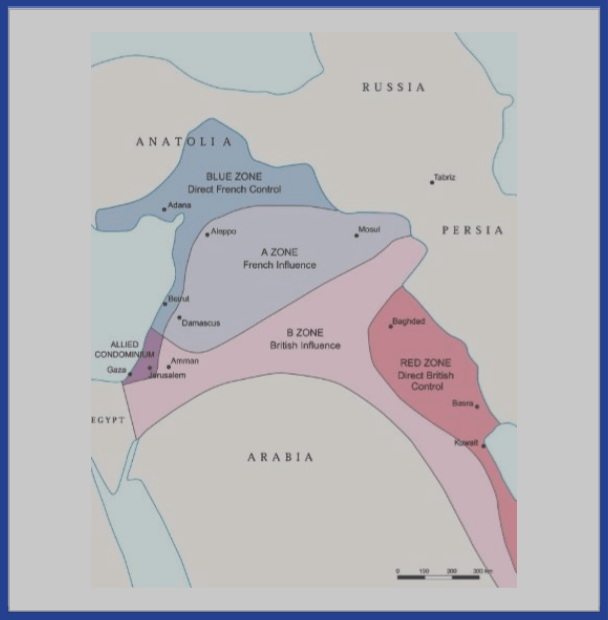
Geography of the Sykes-Picot agreement.5https://en.wikipedia.org/wiki/Partition_of_the_Ottoman_Empire#/media/File:Sykes-Picot-1916.gif
The Sykes-Picot Agreement, officially known as the Asia Minor Agreement, was a secret 1916 agreement between the United Kingdom and France, to which the Russian Empire assented.
The agreement defined their mutually agreed spheres of influence and control in Southwestern Asia. The deal was based on the premise that the Triple Entente would defeat the Ottoman Empire during World War I. The negotiations leading to the agreement occurred between November 1915 and March 1916, and it was signed on May 16, 1916. The deal, exposed to the public in Izvestia and Pravda on November 23, 1917, and in the British Guardian on November 26, 1917, is still mentioned when considering the region and its present-day conflicts.
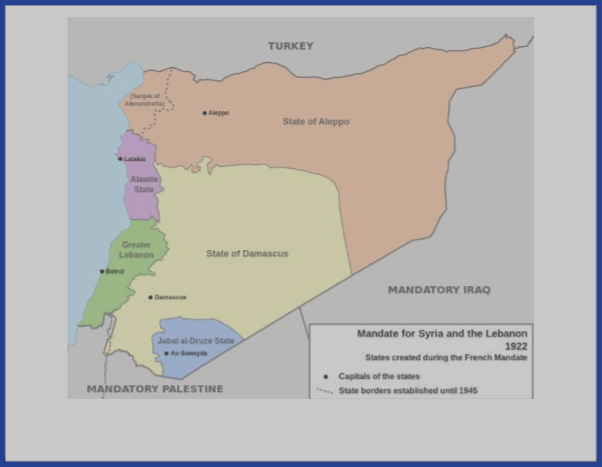
French Mandate of Syria and Lebanon.6Ibid Syria and Lebanon became a French protectorate (thinly disguised as a League of Nations Mandate). French control was met immediately with armed resistance, and to combat Arab nationalism, France divided the Mandate area into Lebanon and four sub-states.
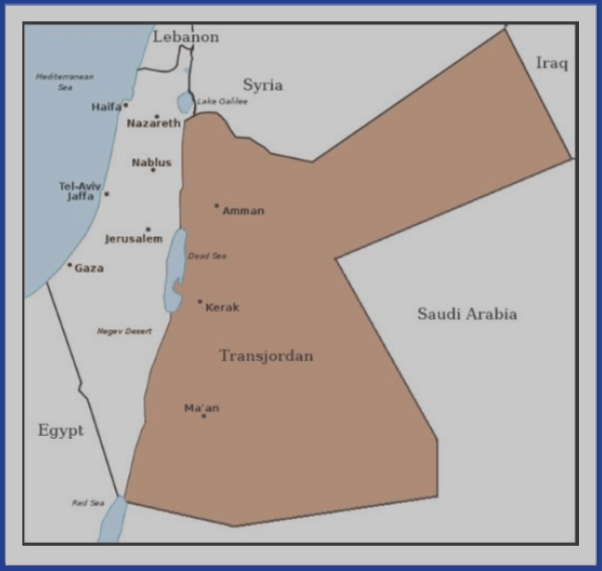
Mandatory Palestine and the Emirate of Transjordan.7Ibid
The British were awarded three mandated territories. Sharif Hussein’s son, Faisal, was installed as King of Iraq and Transjordan, providing a throne for another of Hussein’s sons, Abdullah. Mandatory Palestine was placed under direct British administration, and the Jewish population could increase, initially under British protection. Most of the Arabian Peninsula fell to another British ally, Ibn Saud, who created the Kingdom of Saudi Arabia in 1932.

The surrender of Jerusalem to the British on 9 December 1917 after the Battle of Jerusalem 8https://www.aljazeera.com/indepth/features/2017/10/100-years-balfour-declaration-explained-171028055805843.html
Why was it controversial?9Ibid
The document was controversial for several reasons. Firstly, in the words of the late Palestinian-American academic Edward Said, “made by a European power … about a non-European territory in a flat disregard of both the presence and wishes of the native majority resident in that territory.”
The Balfour Declaration promised Jews a land where the natives comprised more than 90% of the population.
Secondly, the declaration was one of three conflicting wartime promises made by the British. When it was released, Britain had already promised the Arabs independence from the Ottoman Empire in 1915 Hussein-McMahon correspondence.
In a separate treaty known as the 1916 Sykes-Picot agreement, the British also promised the French that most of Palestine would be under international administration. The rest of the region would be split between the two colonial powers after the war. However, the declaration meant that Palestine would come under British occupation and the Palestinian Arabs would not gain independence. Finally, the resolution introduced a reportedly unprecedented notion in international law - that of a “national home.”
The vague term “national home” for the Jewish people, instead of “state,” left the meaning open to interpretation. Earlier document drafts used the phrase “the reconstitution of Palestine as a Jewish State,” but that was later changed. In a meeting with Zionist leader Chaim Weizmann in 1922, Arthur Balfour and then-Prime Minister David Lloyd George reportedly said the Balfour Declaration “always meant an eventual Jewish state.”
Why was it issued?
The question of why the Balfour Declaration was issued has been debated for decades, with historians using different sources to suggest various explanations.
While some argue that many in the British government at the time were Zionists themselves, others say the declaration was issued out of anti-Semitic reasoning, that giving Palestine to the Jews would be a solution to the “Jewish problem.”
In mainstream academia, however, there are a set of reasons over which there is a consensus:
- Control over Palestine was a strategic imperial interest to keep Egypt and the Suez Canal within Britain’s sphere of influence
- Britain had to side with the Zionists to rally support among Jews in the United States and Russia, hoping they could encourage their governments to stay in the war until victory
- Intense Zionist lobbying and securing connections between the Zionist community in Britain and The British government: some of the officials in the government were Zionists themselves
- Jews were persecuted in Europe, and the British government was sympathetic to their suffering.
How did Palestinians and Arabs receive it?10Ibid
In 1919, then-US President Woodrow Wilson appointed a commission to investigate public opinion on Syria and Palestine’s mandatory system. The investigation was known as the King-Crane Commission. It found that most Palestinians expressed strong opposition to Zionism, leading the commission’s conductors to advise a modification of the mandate’s goal.
The late Awni Abd al-Hadi, a Palestinian political figure and nationalist, condemned the Balfour Declaration in his memoirs, saying it was made by an English foreigner who had no claim to Palestine and a foreign Jew who had no right to it.
1920, the Third Palestinian Congress in Haifa decried the British government’s plans to support the Zionist project. It rejected the declaration as a violation of international law and the rights of the indigenous population. The other important source for insight into Palestinian opinion was the Balfour Declaration - the press - which was closed by the Ottomans at the start of the war in 1914. The press only began to reappear in 1919 but under British military censorship.
In November 1919, when the al-Istiqlal al-Arabi (Arab independence) newspaper, based in Damascus, was reopened, one article said in response to a public speech by Herbert Samuel, a Jewish cabinet minister, in London on the second anniversary of the Balfour Declaration: “Our country is Arab, Palestine is Arab, and Palestine must remain Arab.”
Even before the Balfour Declaration and the British Mandate, pan-Arab newspapers warned against the Zionist movement’s motives and its potential outcomes in displacing Palestinians from their land. Khalil Sakakini, a Jerusalemite writer and teacher, described Palestine in the immediate aftermath of the war as follows: “A nation which has long been in the depths of sleep only awakes if events rudely shake it, and only arises little by little … This was the situation of Palestine, which for many centuries has been in the deepest sleep, until it was shaken by the great war, shocked by the Zionist movement, and violated by the illegal policy [of the British]. It awoke, little by little.” Increased Jewish immigration under the mandate created tensions and violence between the Palestinian Arabs and the European Jews. One of the first popular responses to British actions was the Nebi Musa revolt in 1920, which killed four Palestinian Arabs and five immigrant Jews.
Who else was behind it?11Ibid
While Britain is generally held responsible for the Balfour Declaration, it is essential to note that the statement would not have been made without prior approval from the other Allied powers during World War I. In a War Cabinet meeting in September 1917, British ministers decided that “the views of President Wilson should be obtained before any declaration was made.” According to the cabinet’s minutes on October 4, the ministers recalled Arthur Balfour confirming that Wilson was “extremely favorable to the movement.”
France was also involved and announced its support before issuing the Balfour Declaration.
A May 1917 letter from Jules Cambon, a French diplomat, to Nahum Sokolow, a Polish Zionist, expressed the French government’s sympathetic views towards “Jewish colonization in Palestine.”
“It would be a deed of justice and reparation to assist, by the protection of the Allied Powers, in the renaissance of the Jewish nationality in that Land from which the people of Israel were exiled so many centuries ago,” stated the letter, which was a precursor to the Balfour Declaration.
The impact of the Balfour Declaration
Zena Tahhan12https://www.aljazeera.com/indepth/features/2017/10/100-years-balfour-declaration-explained-171028055805843.html writes, “The Balfour Declaration is widely seen as the precursor to the 1948 Palestinian Nakba when Zionist armed groups, whom the British trained, forcibly expelled more than 750,000 Palestinians from their homeland. Despite some opposition within the War Cabinet predicting that such an outcome was probable, the British government still issued the declaration. The developments in Palestine today can be traced back to the Balfour Declaration. There is little doubt that the British Mandate created Jewish conditions for the Jewish minority to gain superiority and build a state for themselves at the expense of Palestinian Arabs.
When the British decided to terminate their Mandate in 1947 and transfer the question of Palestine to the United Nations, the Jews already had an army formed out of the armed paramilitary groups trained and created to fight side by side with the British in World War II. Furthermore, the British allowed the Jews to establish self-governing institutions, such as the Jewish Agency, to prepare themselves for a state when it came to it.
In contrast, the Palestinians were not allowed to do so - paving the way for the 1948 ethnic cleansing of Palestine.
1948 Palestinian exodus - the beginning of the disorder13https://en.wikipedia.org/wiki/1948_Palestinian_exodus
The 1948 Palestinian exodus, also known as the nakba (Arabic: النكبة, al-Nakbah, literally ‘disaster, catastrophe,’ or ‘cataclysm'), occurred when more than 700,000 Palestinian Arabs fled or were expelled from their homes during the 1948 Palestine war.
Between 400 and 600 Palestinian villages were sacked during the war, while urban Palestine was almost entirely extinguished. ‘nakba’ refers to the war period and events affecting Palestinians from December 1947 to January 1949. The precise number of refugees, many settled in refugee camps in neighboring states, is disputed. Still, around 80% of the Arab inhabitants who became Israeli (half of the Arab total of Mandatory Palestine) left or were expelled from their homes. About 250,000–300,000 Palestinians fled or were removed before the Israeli Declaration of Independence in May 1948, a fact.
She named a casus bello for the Arab League’s entry into the country, sparking the 1948 Arab–Israeli War.
The causes are also a subject of fundamental disagreement between historians. Factors involved in the departure include Jewish military advances, destruction of Arab villages, psychological warfare, and fears of another massacre by Zionist militias after the Deir Yassin massacre, which caused many to leave out of panic; direct expulsion orders by Israeli authorities; the voluntary self-removal of the wealthier classes; collapse in Palestinian leadership and Arab evacuation orders; and an unwillingness to live under Jewish control.
Later, a series of laws passed by the first Israeli government prevented them from returning to their homes or claiming their property. They and many of their descendants remain refugees. Some historians have since described the expulsion of the Palestinians as ethnic cleansing, while others dispute this charge.
The refugees’ status and whether Israel will grant them their claimed right to return to their homes or be compensated are critical issues in the ongoing Israeli–Palestinian conflict. Palestinians commemorate the events of 1948 in the Palestinian territories and elsewhere on May 15, now known as Nakba Day.
The plight of the displaced people of Palestine
Some illustrations better describe their challenges.
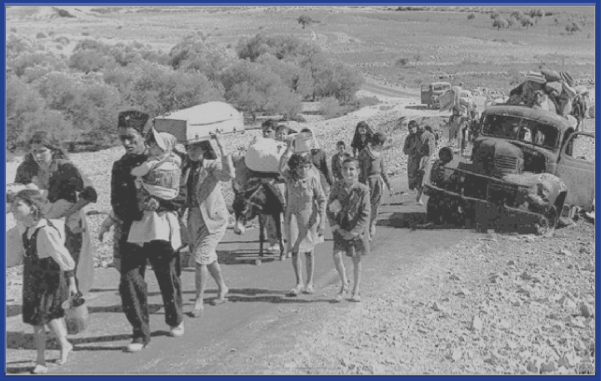
Palestinian refugees leaving the Galilee in October–November 1948.14Ibid
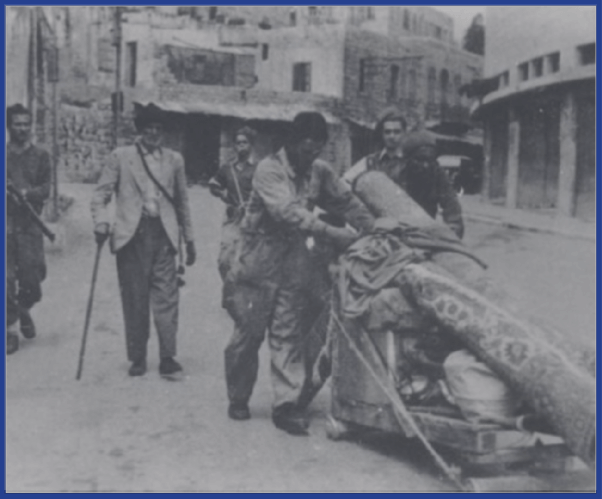
Arabs leaving Haifa as Jewish forces enter the city.15Ibid

A Palestinian person watches over a school in a refugee camp, 1948.16Ibid
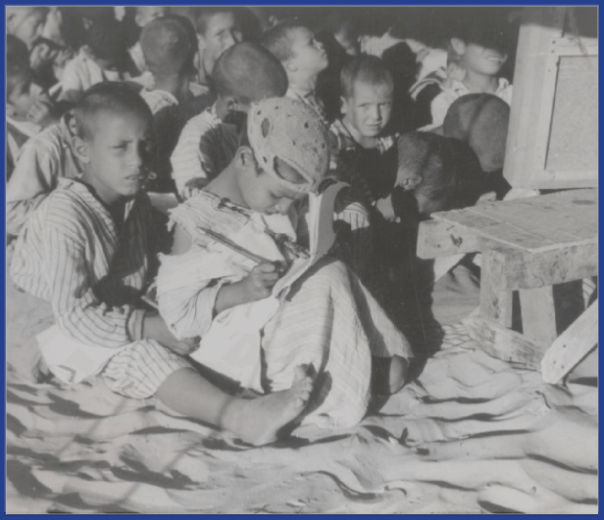
Makeshift school for Palestinian refugees.17Ibid
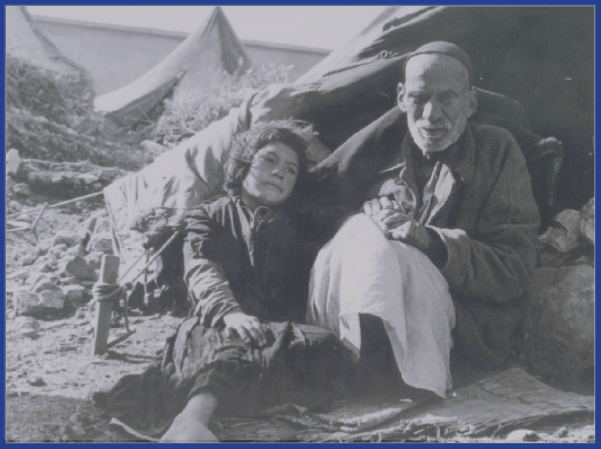
Refugees in the open, 1948.18Ibid
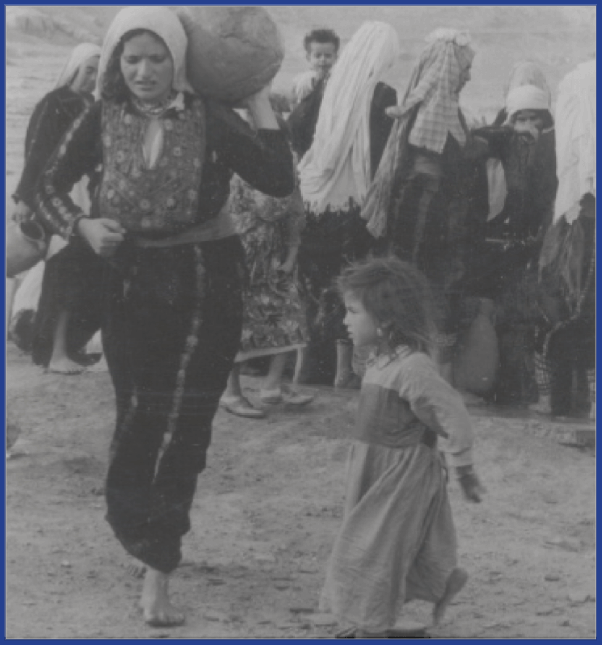
A Palestinian woman and a child.19Ibid

Old and young in the entrance of the tent, 1948.20Ibid
A peek into 4,000 years of Jerusalem History
Graphical Overview of Jerusalem’s Historical Periods21https://en.wikipedia.org/wiki/Template:Graphical_Overview_of_Jerusalem%27s_Historical_Periods from 2000 BC to today will notice 4,000 years of history of one of the most historic and geopolitical cities. The illustration below is a timeline of significant events in the History of Jerusalem.
This a city that had been fought over sixteen times in its history.22Steckoll, Solomon H., The gates of Jerusalem, Frederick A. Praeger, New York, 1968, preface Jerusalem has been destroyed twice during its long history, besieged 23 times, attacked 52 times, and captured and recaptured 44 times.23Do We Divide the Holiest Holy City?". Moment Magazine. Archived from the original on 3 June 2008. Retrieved 5 March 2008. According to Eric H. Cline’s tally in Jerusalem Besieged. The initial period represented by the yellow band is for Canaanite -the rulers of non-Abrahamic religion. The smaller balloon identifies the 250 years of Jerusalem governed by Jews before current Israel. The rule of Christian Crusaders is very brief, approximately 88 years.
The City of Jerusalem has been under Muslim control for 1,200 years – the most extended period, by far, and the most peaceful period for all three Abrahamic religions.
Jerusalem’s history in the last 4,000 years24https://en.wikipedia.org/wiki/Template:Graphical_Overview_of_Jerusalem%27s_Historical_Periods - Over 1,200 years for Muslims vs. 250 years for Jews
Comparison of Jerusalem’s Jewish and Muslim eras over the last 4,000 years.
Conclusion
According to Daniel Gerber,25Gerber, Daniel, https://www.quora.com/If-Islam-is-about-peace-why-arent-Islamic-countries-peaceful Raised fundamentalist Christian, now an atheist. Interacted with many other religions “Buddhism would be one of the most peaceable religions (perhaps after Jainism), but devout Buddhist Cambodia gave us one of the worst genocides in history during the 1970s and 1980s.
Myanmar is Buddhist but has had an authoritarian government, constant wars, and suppression of ethnic minorities. Tibet did, eventually, resist militarily against Chinese occupation. Sri Lanka, the heartland of Buddhism in South Asia, had a bloody civil war for many years. Japanese are mostly Shinto and Zen Buddhists, but they were the aggressors in the Pacific arena of World War 2 and committed many atrocities. So, one cannot just blame all international conflicts on religion. Much as we would like (atheists) to say that Christianity and Islam are responsible for all the evil in the world, that’s not true”.
He continues, adding, “In the case of Muslim countries, can you name one that was not colonized by a European country? The Arab countries were all colonized, until very recently, by Britain or France, or sometimes both. Indonesia was colonized by the Dutch and Malaysia by the British. India, Bangladesh, and Pakistan were, of course, colonized by the British. Kazakhstan and other Central Asian countries were part of the USSR, which you could see as colonization by Russia. European powers, for ages, have fought over Kosovo. Colonization in North America and Australia almost wiped out the indigenous people. Even in Central and South America, it decimated their culture and diluted their bloodline. So, the countries there are inheritors of the European systems. This makes them look like successful colonies”.
“But the indigenous population was not wiped out in most Muslim countries. So, the countries were rebuilt as Muslim countries. Like African or Asian post-colonial countries, this has benefits but challenges. Some international conflicts arise because the borders (Syria, Iraq, Jordan, Kuwait, Saudi Arabia, India, Pakistan, etc.) were drawn up by clueless bureaucrats in Europe’s comfortable offices.
This situation is certainly true in Iraq, and then, of course, the conflict in the Middle East is mainly because Britain and France thought it would be a good idea to take land away from Muslims to import Jews back from America and Europe back to the “holy land,” because, well, that’s what the Bible says.
Then, those Jews thought it would be fun to go through with their armies and kick Muslims out of their houses if they still called al-Nakba. I think most people, regardless of religion, would be angry about that.” He adds, “things in human history and particularly in the study of religions are seldom as simple as one might like.”
A demonstration of the destructive power of misinformation
The attack on the Capitol Building in the US on January 6, 2021, shows the destructive power of misinformation. Even though 60+ US courts found no wrongdoing in the US 2020 Presidential election and several watchdog agencies accepted the election results as fair, many people turned to violence. They attacked their elected leaders in the view of global eyes, watching it minute by minute.
We can easily guess the Muslim world’s damage with Islamophobia and abundant misinformation bombarded by the media and numerous world leaders in the last decades.
Points to Ponder – Let us try to answer these questions
Comparison of Jerusalem’s Jewish Era and Muslim Era in the last 4,000 years (see Volume 2, Jerusalem History in last 4,000 years)
Muslims ruled over Jerusalem for over 1,100 years, 300 years for Jews versus 88 years for Crusaders.
The Muslim Era is from 640 CE to 1940 CE, minus 88 years of complete rule by Crusaders and 104 years of partial control (total 192 years of Crusaders), that is (1,300-192), 1,108 years versus the 300 years of Jewish Era, versus 88 years of Crusaders rule.
Why do all-powerful Western nations have supported dictatorial or absolute monarchies when they should support their move towards democracies?
Why do most powerful nations sell arms to tyrant/autocratic Muslim countries?
Selling Arms to these weak and often tyrant/absolute monarchies is the only way to improve national GDP and create jobs.
Committing unconditional support to one nation, already a nuclear power, is the only way to pursue peace in the Middle East.
When a few of these Muslim nations tried to move away from authoritarian rule towards budding democracies, the West’s powerful countries did not support it.
Exploring answers to the above questions will show us that there has been considerable and continued geopolitics after colonial power.
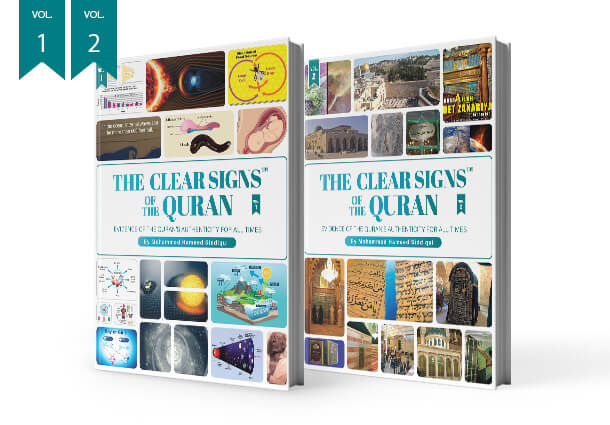 Mohammed Hameed Siddiqui has conducted his multidisciplinary research in several branches of science and humanities that exhibit the Clear Signs in the Quran in the Physical Universe, the Social and Ethical Sphere, the approved practices in Islam, and the events in prophets’ stories. This includes fields of study such as astrophysics, autophagy, the birth of the universe, dermatoglyphics, cosmology, embryology, genetics, geology, the history of Abrahamic prophets, inheritance in Islam, the linguistic coherence of the Quran, the proofs of its unaltered text of God, melittology, oceanography, the prediction of Prophet Muhamad (PBUH) in previous holy books, the reality of jinn, and space-time relativity.
Mohammed Hameed Siddiqui has conducted his multidisciplinary research in several branches of science and humanities that exhibit the Clear Signs in the Quran in the Physical Universe, the Social and Ethical Sphere, the approved practices in Islam, and the events in prophets’ stories. This includes fields of study such as astrophysics, autophagy, the birth of the universe, dermatoglyphics, cosmology, embryology, genetics, geology, the history of Abrahamic prophets, inheritance in Islam, the linguistic coherence of the Quran, the proofs of its unaltered text of God, melittology, oceanography, the prediction of Prophet Muhamad (PBUH) in previous holy books, the reality of jinn, and space-time relativity.
Click Here to Order the Book: "The Clear Signs Of The Quran"
( Source: This article is a book excerpt from "The Clear Signs Of The Quran", the chapter is "Misbelief - Muslims are Solely Responsible for the Turmoil in the Middle East" and is being republished with permission from the author and publisher. The Clear Signs™is a registered trademark of Al-Furqaan Foundation, a 501(C)(3) tax-exempt non-profit organization. Copyrights © 2023. All rights reserved. )
Footnotes
Topics: Balfour Declaration, History, Islamophobia, Israeli Arabs, Jerusalem, Jews, Ottoman Empire, Palestine, Sykes-Picot, World War I, Zionism
Views: 674
Related Suggestions








